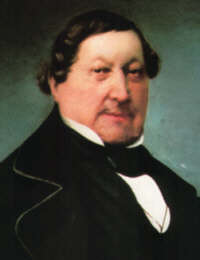
Feb.29 1792〜Nov.13 1868
Rossini・Mass,Sacred songs Literal Translation
Japanese
History of HP renewal Sample of the file
Gioachino Antonio Rossini
The page of the literal translation for Rossini's masses & anthems
It is needless to say that it is how important thing to sing
when each word of the words is fully understood on the occasion of singing a
vocal music text in music.
But there are not many sites or books which
explain the word for word translation of the text.
This page was made by this viewpoint so that it could answer such needs
at all. Though it is still only on the amateur stage, I want to make this
a better page by everyone's support. I am happy if I could have an advice
to me about a point to modify.
Though there are many fundamentally common words among various masses, each mass has its slightly different contents,structure and backgrounds.On the top of these contents,I tryed to explain its proper nouns and the special words and phrases used in masses as well.
You can understand more easily the words if you study the text,listening the actual performance of CDs
In
case of printing,you are advised to download the excel file first and make an
adjustments of its lay-out of the text.
(If you don't
use MicrosoftExcel,you can make use of free soft OpenOffice.org
If you have questions,adviecs or other communications pls email me to
the adress、mondomusicale2006-hp@yahoo.co.jp Y.Kawazu
![]()
John 1--The Word Became Flesh(1-1-14)
1In the beginning was the Word, and the
Word was with God, and the Word was God. 2He was with God in the beginning. 3Through him all things were made;
without him nothing was made that has been made. 4In him was life, and that life was the light of men.
 Mail
Mail
![]() Download
Download
(You may convert Midi to Mp3 using iTune soft after downloading the free
soft by clicking one of the below![]() s.)
s.)
![]()
 |
Rossini Stabat Mater Literal Translation(Under construction) for TIS
|
![]()
Biography of Gioacchino Antonio Rossini (From Wikipedia, the free encyclopedia)
|
Gioachino Antonio Rossini [1] (February 29, 1792 ? November 13, 1868) was an Italian musical composer who wrote more than 30 operas as well as sacred music and chamber music. His best known works include Il barbiere di Siviglia (The Barber of Seville) and Guglielmo Tell (William Tell). Early yearsRossini was born into a family of musicians in Pesaro, a small town on the Adriatic coast of Italy. His father Giuseppe was a horn player and inspector of slaughterhouses, his mother Anna a singer and baker's daughter. Rossini's parents began his musical training early, and by the age of six he was playing the triangle in his father's band. Rossini's father was sympathetic to the French Revolution, and welcomed Napoleon's troops when they arrived in Northern Italy. This became a problem when the Austrians restored the old regime in 1796. Rossini's father was sent to prison, and his mother took him to Bologna, earning her living as lead singer at various theatres of the Romagna region, where she was ultimately joined by her husband. During this time, he was frequently left in the care of his aging grandmother, who was unable to effectively control the boy. He remained at Bologna in the care of a pork butcher, while his father played the horn in the bands of the theatres at which his mother sang. The boy had three years instruction in the harpsichord from Prinetti of Novara, but Prinetti played the scale with two fingers only, combined his profession of a musician with the business of selling liquor, and fell asleep while he stood, so that he was a fit subject for ridicule by his critical pupil. EducationHe was taken from Prinetti and apprenticed to a smith. In Angelo Tesei he found a congenial master, and learned to sight-read, to play accompaniments on the pianoforte, and to sing well enough to take solo parts in the church when he was ten years of age. At thirteen he appeared at the theatre of the Commune in Paer’s Camilla ? his only public appearance as a singer (1805). He was also a capable horn player in the footsteps of his father. In 1807 the young Rossini was admitted to the counterpoint class of Padre P. S. Mattei, and soon after to that of Cavedagni for the cello at the Conservatorio of Bologna. He learned to play the cello with ease, but the pedantic severity of Mattei's views on counterpoint only served to drive the young composer's views toward a freer school of composition. His insight into orchestral resources is generally ascribed not to the strict compositional rules he learned from Mattei, but to knowledge gained independently while scoring the quartets and symphonies of Haydn and Mozart. At Bologna he was known as "il Tedeschino" ("the Little German") on account of his devotion to Mozart |
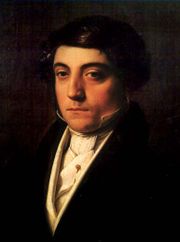  |
Early careerThrough the friendly interposition of the Marquis Cavalli, his first opera, La Cambiale di Matrimonio, was produced at Venice when he was a youth of eighteen. But two years before this he had already received the prize at the Conservatorio of Bologna for his cantata Il pianto d'Armonia sulla morte d’Orfeo. Between 1810 and 1813, at Bologna, Rome, Venice, and Milan, Rossini produced operas of varying success. All memory of these works is eclipsed by the enormous success of his opera Tancredi. The libretto was an arrangement of Voltaire’s tragedy by A. Rossi. Traces of Paer and Paisiello were undeniably present in fragments of the music. But any critical feeling on the part of the public was drowned by appreciation of such melodies as "Di tanti palpiti... Mi rivedrai, ti rivedro," which became so popular that the Italians would sing it in crowds at the law courts until called upon by the judge to desist. Rossini continued to write operas for Venice and Milan during the next few years, but their reception was tame and in some cases unsatisfactory after the success of Tancredi. In 1815 he retired to his home at Bologna, where Barbaja, the impresario of the Naples theatre, concluded an agreement with him by which he was to take the musical direction of the Teatro San Carlo and the Teatro Del Fondo at Naples, composing for each of them one opera a year. His payment was to be 200 ducats per month; he was also to receive a share of Barbaja's other business, popular gaming-tables, amounting to about 1000 ducats per annum. This was an amazingly lucrative arrangement for any professional musician at that time. Some older composers in Naples, notably Zingarelli and Paisiello, were inclined to intrigue against the success of the youthful composer; but all hostility was made futile by the enthusiasm which greeted the court performance of his Elisabetta regina d'Inghilterra, in which Isabella Colbran, who subsequently became the composer’s wife, took a leading part. The libretto of this opera by Schmidt was in many of its incidents an anticipation of those presented to the world a few years later in Sir Walter Scott’s Kenilworth. The opera was the first in which Rossini wrote the ornaments of the airs instead of leaving them to the fancy of the singers, and also the first in which the recitativo secco was replaced by a recitative accompanied by a string quartet. Marriage and mid-careerIn 1822, four years after the production of this work, Rossini married singer Isabella Colbran. In the same year, he directed his Cenerentola in Vienna, where Zelmira was also performed. After this he returned to Bologna; but an invitation from Prince Metternich to come to Verona and "assist in the general re-establishment of harmony" was too tempting to be refused, and he arrived at the Congress in time for its opening on October 20, 1822. Here he made friends with Chateaubriand and Dorothea Lieven. In 1823, at the suggestion of the manager of the King’s Theatre, London, he came to England, being much feted on his way through Paris. In England he was given a generous welcome, which included an introduction to King George IV and the receipt of £7000 after a residence of five months. In 1824 he became musical director of the Theatre italien in Paris at a salary of £800 per annum, and when the agreement came to an end he was rewarded with the offices of chief composer to the king and inspector-general of singing in France, to which was attached the same income. At the age of 32, Rossini was able to go into semi-retirement with essentially financial independence. |
 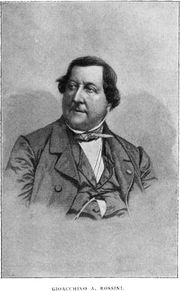 |
End of his careerThe production of his Guillaume Tell in 1829 brought his career as a writer of opera to a close. The libretto was by Etienne Jouy and Hippolyte Bis, but their version was revised by Armand Marrast. The music is remarkable for its freedom from the conventions discovered and utilized by Rossini in his earlier works, and marks a transitional stage in the history of opera. Though a very good opera, it is rarely heard uncut today, as the original score runs more than four hours in performance. In 1829 he returned to Bologna. His mother had died in 1827, and he was anxious to be with his father. Arrangements for his subsequent return to Paris on a new agreement were upset by the abdication of Charles X and the July Revolution of 1830. Rossini, who had been considering the subject of Faust for a new opera, returned, however, to Paris in the November of that year. Six movements of his Stabat Mater were written in 1832 and the rest in 1839, the year of his father's death. The success of the work bears comparison with his achievements in opera; but his comparative silence during the period from 1832 to his death in 1868 makes his biography appear almost like the narrative of two lives ? the life of swift triumph, and the long life of seclusion, of which biographers give us pictures in stories of the composer's cynical wit, his speculations in fish culture, his mask of humility and indifference. Later yearsHis first wife died in 1845, and political disturbances in the Romagna area compelled him to leave Bologna in 1847, the year of his second marriage with Olympe Pelissier, who had sat for Vernet for his picture of Judith and Holofernes. After living for a time in Florence he settled in Paris in 1855, where his house was a centre of artistic society. He died at his country house at Passy on November 13, 1868 and was buried in Pere Lachaise Cemetery, Paris, France. In 1887 his remains were moved to the Basilica of the Holy Cross in Florence, where they now rest. |
 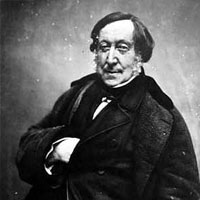 |
![]()
 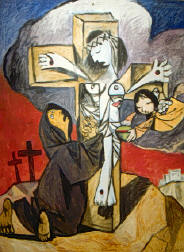 |
Stabat Mater Christians of the 20th century can truly identify with Our Lady's experience of Sorrow. The message of the Stabat Mater focuses on the spiritual and emotional bond which unites Mary and all Christians to the death of her Son on the Cross. From this bond, each Christian can recognize the incredible compassion and holiness in Mary's character. The Blessed Mother demonstrated her maternal compassion to all generations of Christians by her presence and participation with her Son Jesus in the Sacrifice of the Cross. There is a mother-son bond that unites Mary with Christ Jesus during his experience of suffering and death. This empathetic bond indicates that Our Lady shared in her Son's suffering. Mary is Our Lady of Sorrows precisely because her Son Christ Jesus bore the sins of the world during his passion and death. As the faithful disciple, Our Blessed Mother invites us to unite our personal suffering with her own. We can share in Jesus' burden on the Cross, just as Mary did at Calvary. As Our Lady of Sorrows, Mary also reminds us that Christians are called to expiate for his or her own sins and the sins of their neighbors, and the sins of the world. We can share in the bond between the Blessed Mother and Our Lord through fasting, prayer, and contrition for sin. Our Lady of Sorrows teaches us that the Crown of eternal life in Heaven can be reached when we each choose to share with Our Lord in His suffering and death on the Cross at Calvary. The compassion of Mary is part of the mystery of the Church community's sharing in, and offering, the Sacrifice of Jesus for the salvation of the world. Each member of the Church has a role to play in redeeming the world. Our Lady of Sorrows is a guide who inspires and teaches us how to be compassionate. It has been set to music by many composers, among them Joseph Haydn, Antonin Dvo?ak, Antonio Vivaldi, Emanuele d'Astorga, Gioacchino Rossini, Giovanni Battista Pergolesi, Charles Villiers Stanford, Charles Gounod, Krzysztof Penderecki, Francis Poulenc, Karol Szymanowski, Alessandro Scarlatti (1724), Domenico Scarlatti (1715), Pedro de Escobar, Arvo Part, Josef Rheinberger and Giuseppe Verdi. Stabat Mater, composed in the operatic style, was originally written under the
guarantee that it would only be performed privately. |
![]()
![]() Portal site HP
Portal site HP
![]() Requiem
Requiem
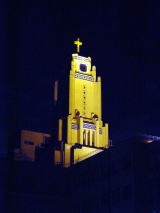 MASSTo the top page
MASSTo the top page
![]() Arie/Canzoni Italiane
Arie/Canzoni Italiane
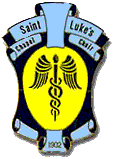

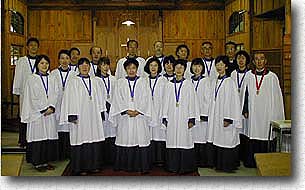
![]()
![]() Year Schedule of My Next stages
Year Schedule of My Next stages
![]() Feb.9,2008(Sat) 7pm Brahbms:Ein deutsches Requiem(Meguro persimmon)
Feb.9,2008(Sat) 7pm Brahbms:Ein deutsches Requiem(Meguro persimmon)
![]() May 10,2008(Sat) 7PM(Suginami Koukaido-Ogikubo) Rossini:Petite Messe Solennenlle
May 10,2008(Sat) 7PM(Suginami Koukaido-Ogikubo) Rossini:Petite Messe Solennenlle
![]() BRITISH EMBASSY CHOIR UPCOMING CONCERTS
BRITISH EMBASSY CHOIR UPCOMING CONCERTS![]()
For discouted tickets available Mail
Mail
![]()
 Finished Concerts(Main ones)
Finished Concerts(Main ones)
![]() Feb.9,2008(Sat) 7pm Brahbms:Ein deutsches Requiem(Meguro persimmon)
Feb.9,2008(Sat) 7pm Brahbms:Ein deutsches Requiem(Meguro persimmon)
![]() Nov.2,2007 Mozart :Requiem(St.Luke International Chapel)
Nov.2,2007 Mozart :Requiem(St.Luke International Chapel)
![]() Feb.9,2008(Sat) 7pm Brahbms:Ein deutsches Requiem(Meguro persimmon)
Feb.9,2008(Sat) 7pm Brahbms:Ein deutsches Requiem(Meguro persimmon)
![]() Msy 10,2008(Sat) 7PM(Suginami Koukaido-Ogikubo) Rossini:Petite Messe Solennenlle
Msy 10,2008(Sat) 7PM(Suginami Koukaido-Ogikubo) Rossini:Petite Messe Solennenlle
For discouted tickets available Mail
Mail
![]() 2007 St.Luke's International Hospital, Chapel Choir
2007 St.Luke's International Hospital, Chapel Choir
Summer Concert Program
Date: Aug.26(Sun) 2007 arround 10:30 after the Service
Place: Karuizawa Shaw Memorial Chapel
Program:1) Locus iste A.Bruckner 2) Tantum ergo A.Bruckner 3) Virga esse
A.Bruckner
4) Jesu dulcis memoria T.L.Victoria 5) Panis angelicus G.P.Palestrina 7)
Above all praise F.Mendelssohn Etc.
Karuizawa Shaw Memorial Chapel

![]() 5/12(Sat)7pm Tokyo International Singers
5/12(Sat)7pm Tokyo International Singers
Program:Rossini Stabat Mater & Puccini Messa di Gloria![]()
Tokyo new city orchestra
Conducted by: Marcel L'Esperance
Soprano:Kaori Hirai Mezzo Sop:Machiko Suzuki Tenor:Dominique Morarez
Bass:Tetsuo Kitamura
Venue:Meguro Persimmon Hall Tichet Price:¥2,900
![]() 3/18(Sun):Schubert Mass No.6 Concert
3/18(Sun):Schubert Mass No.6 Concert
Conducted by:Bon Fujisaki Senzoku Orchestra
Venue: Maeda-hallSenzoku Maeda Hall(SENZOKU MUSIC College)
By :Senzoku Gakuen college of Music Kanai seminar
Co-By :Franz Schubert Society
![]() 2/18(Sun)Charity Concert
2/18(Sun)Charity Concert ![]()
Program:Schubert Mass No.6、Kyrie,Gloria Sopranos solo,Piano & Organa soloソプラ
Venue:Catholic Saginuma Church 14:30pm Tichet Price:¥2000(To be donated for Church renewal Construction)
![]() Bruckner 《Mass No.3"Mass in F minor" 》 Brahms 《Nanie 》
Bruckner 《Mass No.3"Mass in F minor" 》 Brahms 《Nanie 》
Feb.10 2007(Sat) at 7:00Pm
Tokyo International Singers With Tokyo City orchestra
Conducted by: Marcel L'Esperance Venue:New Suginami Hall New Suginami-ku Large Hall
![]() Countdown Concert of Beethoven No.9 at IKSPIARI
Countdown Concert of Beethoven No.9 at IKSPIARI
19pm in Dec.31 Disney Resort
Directed by Takashi Kinoshita Urayasu City Orchestra
◆Solists◆
Soprano:Toshimi Nagayasu Alto:Tomoko Kasahara Tenor:Izumi Furusawa Bass:Licht Furusawa
Chorus:IKSPIARI CountDown No.9 Chorus Chorus Director:Licht Furusawa
![]() Gloria chapel in ShinagawaMessiah:
Gloria chapel in ShinagawaMessiah:
Dec.5(Tue) at 6pm Venue:Gloria chapel
Program:Oratorio Messiah HWV.56 G.F.Handel
Conducted by:Keizo Fujimoto
![]() St.Luke's International Hospital, Chapel Choir
St.Luke's International Hospital, Chapel Choir![]()
Summer
Concert Program
Date: Aug.27(Sun) 2006 arround 10:30 after the Service
Place: Karuizawa Shaw Memorial Chapel
Program:O saviour of the world(J.Goss&A.Somervell)、
Haec dies(J.Arcadert&W.Byrd)
Ave verum corpus(E.Elgar&W.A.Mozart)
Karuizawa Shaw Memorial Chapel

![]() Prof.KanaiSeminar's Ensemble & Schubert Mass No.6 Concert
Prof.KanaiSeminar's Ensemble & Schubert Mass No.6 Concert
July.15(Sat):13:30〜SCHUBERT Choir(Soli)(Will take Solo part together with
students)
Program:Schubert Mass No.6 Conductor : Mayumi Motomura
Orchestra :Senzoku Gakuen
Orchestra
Venue: Nissay Theater
Pilotis Nissay Theater Performance
Schedule
By :Senzoku
Gakuen college of Music Kanai seminar
Co-By :Franz
Schubert Society
![]() Quarto
Incontro Musicale
Quarto
Incontro Musicale
Main sponsor;Studiolo(Italian Language School)
EVENING FOR iTALIAN ARIAS AND CANZONE
(I SANG Mozart:Dalla sua pace AND Non ti scordar di me
Sept.16(Sun)July 2006 1
![]()
| MY main repertory |
Since Aug.31 2006 HP Analysis
![]()
![]()












